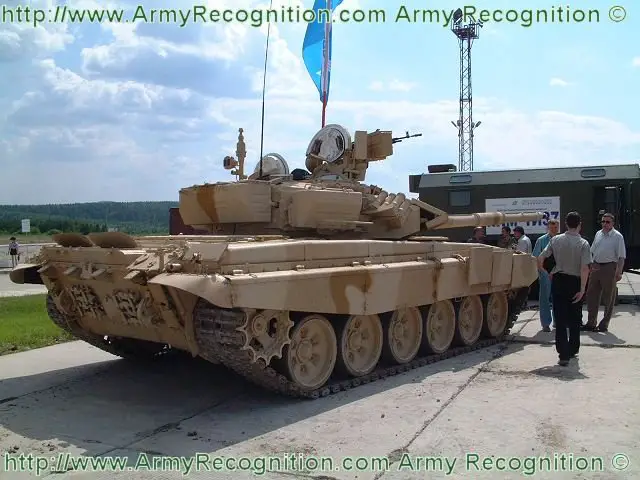Breaking news
Russia had sold a $14.5 billion worth of weapons in 2015 TASS 33003165.
| 2016
|
|
|||
|
Defence & Security News - Russia
|
|||
|
|
|||
| Russia had sold a $14.5 billion worth of weapons in 2015 | |||
|
Russian President Vladimir Putin said at a session of the Military-Technical Cooperation Commission in Nizhny Novgorod that Russia had sold a $14.5 billion worth of weapons in 2015 and its orderbook swelled to $56 billion, having broken the 1992 record.
|
|||
|
|
|||
 Sukhoi Su-30MK (MKM-export version) russian made two-seat multirole fighter aicraft Sukhoi Su-30MK (MKM-export version) russian made two-seat multirole fighter aicraft |
|||
|
|
|||
|
Combat gear was exported to 58 countries, but the key customers for Russia’s materiel were India, Iraq, Vietnam, China and Algeria. These nations generated most of the profits in 2015. For instance, India received 12 Sukhoi Su-30MKI (NATO reporting name: Flanker-H) fighter knockdown sets, 23 Mil Mi-17V-5 helicopters and AL-31FP and RD-33 aircraft engines and had its Project 877 (Kilo-class) Sindhukitri diesel-electric submarine, six Kamov Ka-31 (Helix) helicopters and other hardware upgraded to the tune of a total of $4 billion at the least.
Russian armament was exported to Iraq in 2015 under the deals clinched in 2013. The deliveries included Mi-35M (Hind), Mi-28NE (Havoc) and Mi-171Sh (hip) helicopters, Pantsir-S1 (SA-22 Greyhound) air defense missile/artillery systems, TOS-1A self-propelled flamethrowers and T-72B main battle tanks, with the hardware being worth in excess of 41 billion. Vietnam took delivery of two Project 636.1 Varshavyanka-class (Improved Kilo-class) diesel-electric submarines, four Su-30MK2 fighters and associated munitions - a total of about 41 billion. Six Mi-26T (Halo) heavylift helicopters, a batch of Pantsir-S1 AD systems and a consignment of T-90SA tanks have been shipped to Algeria and the modernization of their fleet of infantry fighting vehicles (IFV) to BMP-2M standard commenced. This earned Russia around $800 million). China in 2015 limited itself to several Ka-32 (Helix) helicopters and D-30KP2 aircraft engines. In addition, Egypt placed several lucrative orders worth at least $5 billion for MiG-29M (Fulcrum) fighters, Buk-M2E (SA-SA-17 Grizzly) and Antei-2500 (SA-23 Gladiator/Giant) surface-to-air missile systems and 46 Ka-52 (Hokum-B) helicopters. The execution of the orders will carry on this year. The agreements with CIS countries, mentioned by Vladimir Putin, contributed to the profits too. For instance, Azerbaijan received T-90S tanks, BMP-3 IFVs, Mi-17V-5 helicopters and the last 18 of the TOS-1A self-propeller flamethrower systems ordered, having paid at least $600 million. As far as the members of the Collective Security Treaty Organization are concerned, commercial deliveries took place only to Belarus (four Yakovlev Yak-130 combat trainers) and Kazakhstan (four Su-30SM fighters). Although the deliveries earned modest money, they were profit-generating deals, rather than free-of-charge supplies. The Russian Defense Ministry’s surplus materiel was exported free of charge to Belarus (four S-300PS SAM battalion sets), Kazakhstan (five S-300PS SAM battalions sets) and Kyrgyzstan (10 BTR-70M armored personnel carriers). |
|||
|
|
|||
 Russian-made T-90S main battle tank Russian-made T-90S main battle tank |
|||
|
|
|||
|
Last year, Rosoboronexport encountered not only stiff competition and tougher customer requirements, but a reduction in the income of its traditional customers as well - due to the diminishing oil prices in the first place. Nevertheless, this did not prevent Algeria either from ordering 42 Mi-28NE helicopters and a squadron worth of Su-32 (Fullback’s export variant) tactical bombers or from testing a Su-35 (Flanker-E) fighter in country. In addition, talks are in progress on several battalion sets of Antei-2500 SAM systems.
Great expectation in 2016 is being had for China and India. The former has been launch customer for Russian cutting-edge systems for two years at a stretch, having been the first foreign buyer to order four S-400 (SA-21 Growler) SAM battalion sets ($1.9 billion) in September 2014 and for 24 Su-35 fighters (about $2 billion) in November 2015. Russia and India are negotiating a deal on two Project 636 submarines and, as Federal Service for Military-Technical Cooperation Deputy Director Vladimir Drozhzhov gas admitted, a lease of another Project 971 nuclear-powered submarine. Talks with Saudi Arabia have become more active too. Riyadh has displayed interest in the S-400 SAM and Iskander-E tactical ballistic missile systems. The negotiations with Riyadh are expected to be difficult and unpredictable, however. The lifting of the embargo on the delivery of S-300PMU-2 (SA-20B Gargoyle) SAM systems to Iran and the contract for them signed in 2015 led to rapprochement between the two countries, but Iran’s desire to buy them upon tally, coupled with the UN Security Council’s sanctions, is hampering the deal. |
|||
|
|
|||
|
© Copyright 2016 TASS. All rights reserved. This material may not be published, broadcast, rewritten or redistributed.
|
|||



















